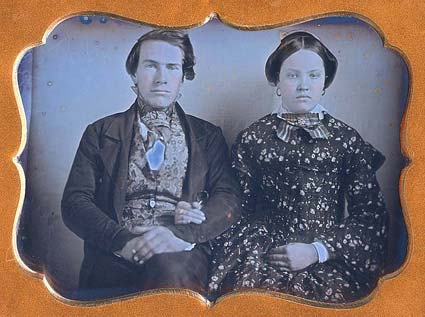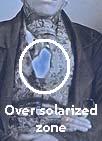|

Blue dag 1
(By courtesy of Paul I.Johnston)

Blue dag 2
(By courtesy of Paul I.Johnston)
|
This sounds like
the title of a thriller, doesn't it?
The purpose of
this page is to resolve the strange case of those daguerreotypes appearing
with a heavy dominance of blue all over their surface.
Most
daguerreotypes present a sharp focus which reveals a high level of detail,
even after more than 150 years of existence. So, the case of dags showing
such a saturation of blue color instead of the regular grey levels they
normally offer, is quite strange.
Different
assumptions have been evoked to explain this curious and uncommon rendition
of the image:
 |
The first one is
based on the possible oxidation of the plate. As any piece of silver,
daguerreotype plates become tarnished when exposed to the atmospheric
pollutions. This deterioration is induced by sulfide and silver oxide
covering the whole plate in a colored film. This can appear as yellow, red
or blue depending on its thickness. Generally, this deterioration is
progressive; starting from the middle of the plate and growing progressively
to its edges.
This is clearly not a valid explanation for a true "blue dag" which is
evenly blue and was like this from its first day. It is possible to find
blue dags for which the photographer had to tint clothes such as shirts, to
make them more visible.
|
 |
The other option
which is also put forward is the possibility of a too intense warming of the
plate during the gold toning process.
This explanation is not relevant here, as blue dags exist which did not
receive a gold toning process. More, in case of an inappropriate warming,
the blue color would not appear homogeneous on every part of the plate,
which should have taken different temperatures.
|
In fact, the
true explanation is just a too intense solarization (overexposure) of
the plate during the shooting of the portrait.
The image on the
right gives evidence of this issue. The white areas of the image appear
irridescent, as if the metal was visible.
Today, an
e-photographer would just erase the over-exposed image from his digital
camera, but in the 1840s, a portrait was something not so common, long to
obtain and expensive. In such conditions, even when not so perfect, clients
kept these blue portraits with them for posterity.
|


Nombre
de visiteurs